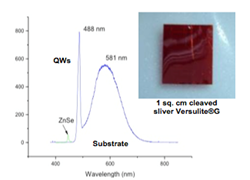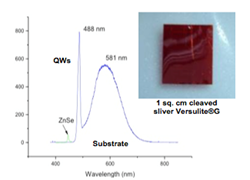Novel 2D Materials let II-VIs Challenge Phosphors, Quantum Dots in Lighting and Optoelectronic Devices


Winooski, Vermont (PRWEB) October 15, 2014
VerLASE Technologies announced today the U.S. Patent Office has issued US Patent No. 8,859,412 on the use of certain 2D materials to grow semiconductor structures that can emit light in green to red colors, getting around a key technical problem with LEDs used today in lighting and with laser diodes. Currently, the primary light emitting technology for much of the visible spectrum is based on Gallium Nitride and its variants, but these materials tend to natively produce only blue or violet light. To get true green, yellow, and red colors, or mix them for white, the color that is directly emitted must be converted with the help of various phosphors, which can include Quantum Dots (QDs). Such down conversion to longer wavelength colors results in some loss in efficiency and increased thermal effects. Traditional phosphors are also temperature sensitive, causing color shifts, brightness degradation, reduced lifetimes, and other problems. Moreover, they tend to emit over a broader band with suboptimal colors and poorer color saturation, and suffer large variability in the manufacturing process.
VerLASE has instead been working with so-called II-VI materials, ironically well-known light emitters that had been extensively researched in the past before Gallium Nitride took the stage. II-VI materials can directly emit colors in the visible spectrum where Gallium Nitride cannot, efficiently closing the infamous “green/yellow” gap in the industry. They are, in fact, the same materials typically used in many of today’s QDs used as phosphors or color enhancement films in the visible spectrum. The problem with II-VI materials in the past had been very short lifetimes due to extensive defects in the materials stemming from how they were grown, and in the crystalline phase in which they were grown, a so-called Zinc Blende phase. The issued patent reveals how to grow such materials in a hitherto very difficult to attain Wurtzite phase by using certain layered 2D materials as templates. The Wurtzite phase is far more robust and resistant to defect formation than the Zinc Blende phase, enabling practical light emitting devices to be made based on semiconductor Quantum Wells (QWs) of these materials.
“This is a key innovation for several important applications,” stated Professor Maria Tamargo, Professor of Chemistry at the City College of the City University of New York, and a leading expert on II-VI materials and devices, adding that “VerLASE has shown for the first time a novel, commercially feasible way to grow Wurtzite phase II-VI crystal films, a focus area of research worldwide”
“Using certain layered 2D materials enables us to grow II-VI based QWs for a variety of devices,” said Ajay Jain, VerLASE’s Chief Technical Officer and inventor of the technology, adding his appreciation to a number of collaborators who had helped demonstrate the process. The Company had been operating in a semi-stealth mode since its launch in 2013, focusing on further developing its technology and manufacturing processes. It is further working to show exfoliated 2D materials as the active layer in novel, electrically pumped LEDs, and in optically pumped devices.
“As exciting as this is, further patents are in the pipeline – we are actively exploring with several leading OEMs how to replace phosphors,” stated Company CEO George Powch, adding that the Company also has a sister company, VersufleX Technologies (http://www.versuflex.com) with a proprietary method of depositing exfoliated 2D materials. It has shown certain exfoliated 2D materials deposited in ultra-thin, uniform layers to act as a phosphor, or even as a monolayer of QWs to rival QDs for a broad variety of applications.
VerLASE Technologies LLC is a Vermont based startup, operating semi-virtually with partners around the world. It spun out of Versatilis LLC (http://www.versatls.com) in 2013 with an investment by Wakley Limited, a Hong Kong based private investment group. Founded by Versatilis’ principals George Powch (CEO) and Ajay Jain (CTO), it focuses on novel materials and processes for VCSELs (Vertical Surface Emitting Laser Diodes), novel LEDs, and replacing phosphors with semiconductor QWs, extending in part 2D layered materials branded as Versulite®, developed by Versatilis in part with the help of numerous Small Business Innovation Research (SBIR) Awards from U.S. Government Agencies including DOE, DARPA, ONR and ARL.
Find More Chemistry Press Releases